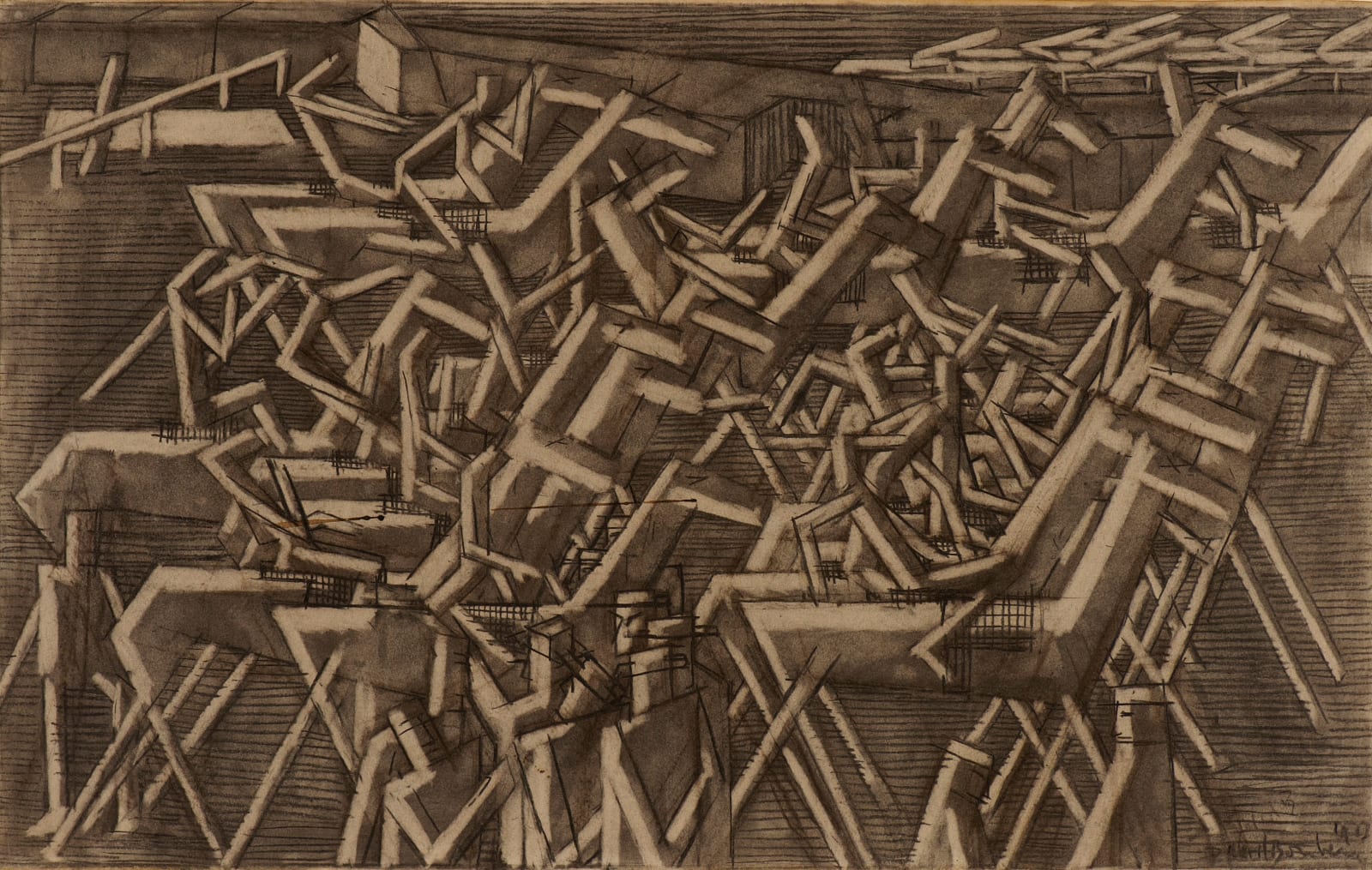David Bomberg 1890-1957
Racehorses, 1913
black chalk and wash on paper
41.5 x 66.2 cm
and dated (lower right): D. Bomberg 1913
2004-8
© David Bomberg estate
Photo: Bridgeman images
This radical chalk-and-wash drawing was among Bomberg's five exhibits in the ‘Jewish Section’ that he co-curated with Jacob Epstein at the Whitechapel Art Gallery’s exhibition Twentieth Century Art: A Review...
This radical chalk-and-wash drawing was among Bomberg's five exhibits in the ‘Jewish Section’ that he co-curated with Jacob Epstein at the Whitechapel Art Gallery’s exhibition Twentieth Century Art: A Review of Modern Movements. Bomberg's friend John Rodker (a racing enthusiast) also reproduced it as a frontispiece in The Dial Monthly, explaining that it was set in a paddock at a race meeting, that the two figures on the front right of the composition were bookies, those to their left spectators, and that the style was ‘cubist’; adding ‘It is not intended to be comic’. Executed in 1913, when Bomberg was only 22, Racehorses is a key transitional work, which demonstrates his absorption and understanding of the contemporaneous European avant-garde, skilfully reworked into a drawing of startling power and originality.Even before he became a student at the Slade School of Fine Art, Bomberg had begun to employ a shallow picture space and to simplify his forms. By 1913 he was producing ‘Cubist compositions’ including one featuring the wooden ‘donkey’ on which students sat to sketch in the Slade life class (which bears a close resemblance to Bomberg’s stiffly-jointed racehorses). His understanding of Cubism was enhanced by his visit to Paris in 1913 and he was also aware of the 1910 Futurist Manifesto with its explanation that ‘a running horse has not four legs, but twenty, and their movements are triangular’. He shared a fascination with mechanisation with the nascent Vorticist movement, reflected in his manifesto accompanying his first solo show at the Chenil gallery, London, in July 1914, where he explained that his object was ‘the construction of Pure Form’. However Bomberg also combined modernist techniques with allusions to older processes: the close-grained texture of the picture is reminiscent of woodcuts, and the monochrome colouring akin to that in photography of the day. He would have been familiar with Eadweard Muybridge’s famous photographs of the ‘animal in motion’, and his racehorses also neatly illustrate what Muybridge himself noted in his ‘Prelude to Analyses’, that ‘during very rapid motion by a good horse, the aggregate of the body preserves a nearly horizontal line'. Like Bomberg’s other innovative works, Racehorses was generally viewed with hostility and incomprehension when first exhibited with the Jewish Chronicle calling his racehorses ‘Opposed to all that is rational in art’.
Provenance
Acquired at Sotheby's in 2004; Ben Uri was generously represented in this acquisition by James Holland-Hibbert of Hazlitt Holland-Hibbert with the assistance of Art Fund, the HLF and the MLA/ V&A Purchase Grant Fund, The Julius Silman Charitable Trust, Pauline and Daniel Auerbach, Sir Michael and Lady Heller and anonymous donorsExhibitions
Selected Highlights from over 200 works acquired during 2003-2013;Bomberg's Relevance;Whitechapel BoysLiterature
Rachel Dickson and Sarah MacDougall, eds., 'Out of Chaos: Ben Uri; 100 Years in London' (London: Ben Uri Gallery, 2015) pp. 40-41.Be the first to know – Sign Up
Subscribe to our newsletter and be the first to know about everything new at Ben Uri, including the constantly evolving and expansive online content across our exhibitions, collection and research.
We value and respect your privacy. Your personal data will be kept private and processed securely, according to our Privacy Policy. If you change your mind anytime, you can unsubscribe directly when receiving a mail from us (the link will be at the bottom of the email) or contact us.
* denotes required fields
This website uses cookies to improve your experience. If you are not happy with this, you can opt-out below.


